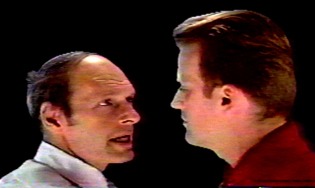Jerry Hunt's Four Video Translations
by Rod Stasick
NOTE: Composer Rod Stasick
manages the archives of Jerry Hunt. He wrote this text in 1994. Four
Video Translations is a videotape available from oodiscs (see Jerry
Hunt: recorded works), which includes the following works: Birome [zone]:
plane (fixture), Bitom (fixture): topogram, Talk (slice): duplex
and Transform (stream): core. The photo of Jerry Hunt and Rod Stasick is
taken from Talk (slice): duplex.
 Talk
(slice): duplex and Birome (zone): plane (fixture) exist as
video translations of Talk (slice) and Birome (zone):
plane respectively. These are two of Jerry Hunt's works that I embraced
wholeheartedly when asked to help with their realization, because of the close
affinity I'd felt with him personally and artistically.
Talk
(slice): duplex and Birome (zone): plane (fixture) exist as
video translations of Talk (slice) and Birome (zone):
plane respectively. These are two of Jerry Hunt's works that I embraced
wholeheartedly when asked to help with their realization, because of the close
affinity I'd felt with him personally and artistically.
Detailing the translative, generative, and/or
transformational bases of these video works could be quite overwhelming to the
reader of these notes. Many of his approach strategies used the Kelley/Dee
Enochian tablet structures as mechanism formalities. These are magical patterns
using letter, word, sign and number combinations within a system of grids
received through the vision experience of Edward Kelley and transcribed by John
Dee during a stay in Bohemia (ca. 1582-9).
Having the chance to scan a score of a Jerry
Hunt composition, one might feel that the birth of a successful performance
could only come about through an immaculate extrication of his ideas from a
field of action requirements. The element of specificity was a hallmark of his
manuscripts, but it was not an unmoving one. When approached by a performer who
may have had difficulties with a particular procedure, instruction was always
offered and performer-isolated.
Frequently, Jerry felt that video recordings of
his live performances were not necessarily good representations of his art. This
attitude could be construed as a diffidently relayed one or, more so I believe,
a feeling that much of the performer/viewer interactive nature of the work would
be lost in its transferal to this medium. The term translation (as in Four
Video Translations) differentiates a visual reworking of a public
performance (or medium-specific activity) from a transferal -- a
recorded exercise, usually with extraneous ornamentation, for the benefit of
posterity.
These translations were created with you, the
view, in mind, because one can observe the inherent intensity of Jerry's
interactive participation in a social and personal way -- a blinding of the
art idolater -- redefining ideas about "proper" performance and
duplicating those in his own personal way.
Jerry Hunt was my best friend. in requesting
that his work and ideas continue to circulate, I wondered how it could be
possible to divorce the man from his vision and still fulfill this request.
Extracting and compiling notes, ideas, letters and more while disseminating
scores and interpretations will eventually, but not finally, lead to an
electronic audio/video interactive retrieval system that would be a
foundation for others and their "transformational and translative
uses".



Original Material Copyright © 1994 by Rod Stasick. HTML Coding Copyright ©
2001–2016 by Michael Schell. All
Rights Reserved.
 Talk
(slice): duplex and Birome (zone): plane (fixture) exist as
video translations of Talk (slice) and Birome (zone):
plane respectively. These are two of Jerry Hunt's works that I embraced
wholeheartedly when asked to help with their realization, because of the close
affinity I'd felt with him personally and artistically.
Talk
(slice): duplex and Birome (zone): plane (fixture) exist as
video translations of Talk (slice) and Birome (zone):
plane respectively. These are two of Jerry Hunt's works that I embraced
wholeheartedly when asked to help with their realization, because of the close
affinity I'd felt with him personally and artistically.